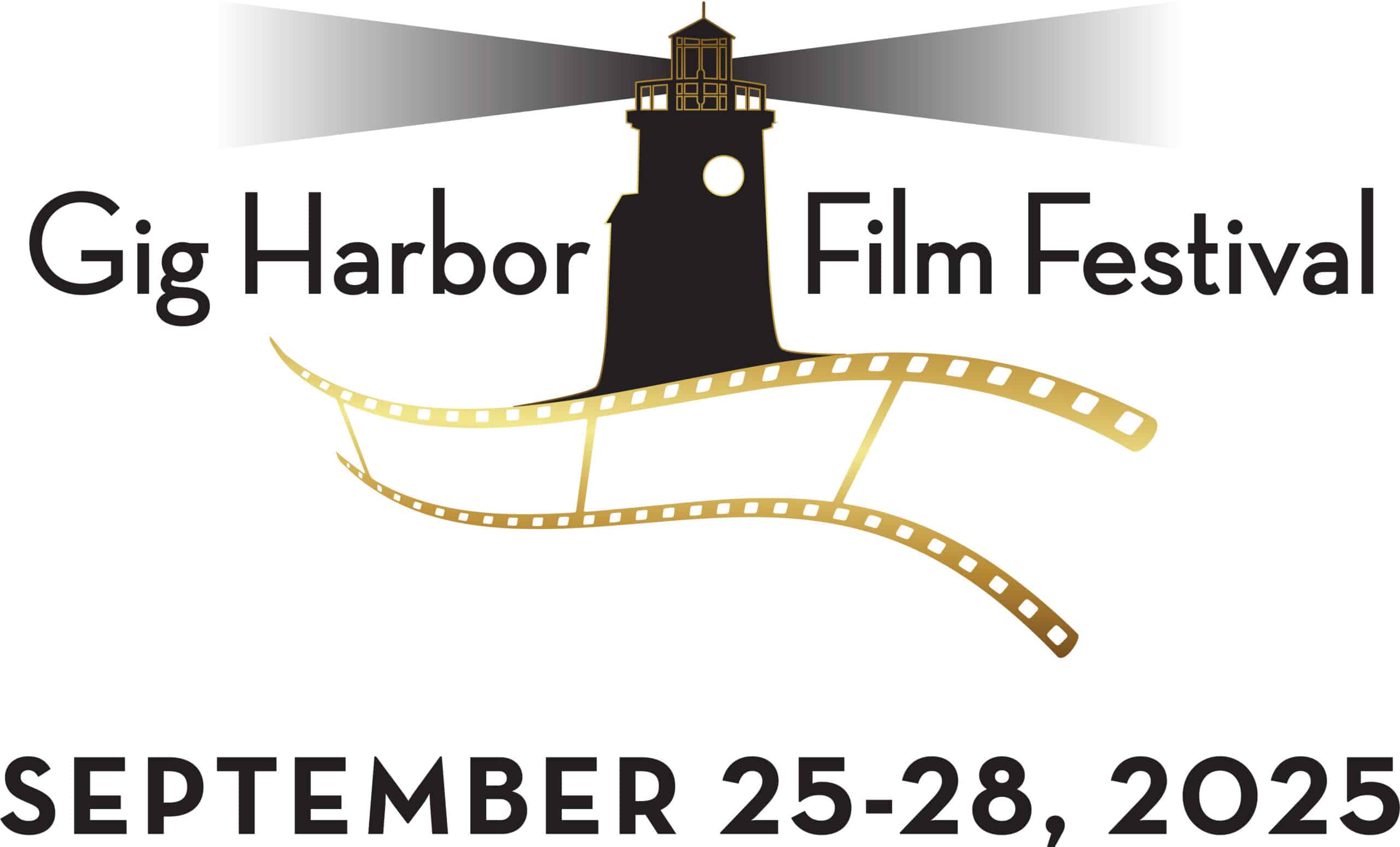Arts & Entertainment Community
Day Tripper | Park once, play all day at the Seattle Center
Labor Day is in our rearview mirror. The kids are back in school. That makes it a great time to visit (or more likely revisit) the Seattle Center. The crowds should be much reduced, and it’s still mild enough that you won’t freeze your tush going from exhibit to exhibit.
Arts & Entertainment Sponsor
Arts & Entertainment stories are made possible in part by the Gig Harbor Film Festival, a proud sponsor of Gig Harbor Now.
I first visited the Seattle Center soon after we transplanted to Gig Harbor in 1979. We had, of course, heard, learned and seen much about the Space Needle and were eager to see it for ourselves. Within days of arriving in Washington state, the kids had an already dog-eared copy of Stephen Cosgrove’s 1974 children’s book “The Wheedle on the Needle,” and I’m sure they had at least one stuffed Wheedle. So, it wasn’t long before we grabbed the first opportunity to head north to the big city. Destination Seattle Center.
There was so much publicity around the 1962 World’s Fair and the opening of the Space Needle that we assumed that was also when the center was built. It was surprising to learn that Seattle Center itself was already over 50 years before it became a world-famous destination.
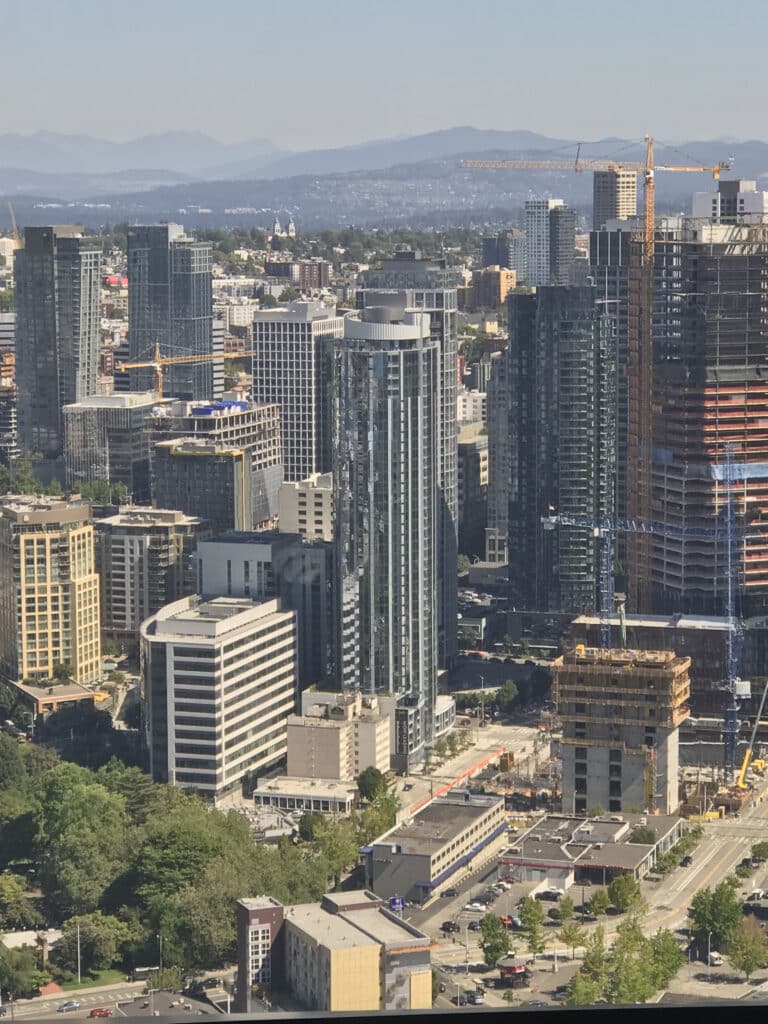
A view of downtown Seattle from atop the Space Needle. Photo by Mary Williams
Getting there
Everyone most likely knows how to get from Gig Harbor to Seattle, so I won’t recreate that wheel. Once in the city, all you need to do is locate the 74-acre parcel that sits between Mercer Street, Denny Way, Fifth Avenue, and Queen Anne Avenue N.
You can chose from a variety of parking lots and garages. Do yourself a favor and do a quick online search so you know what’s available and the various rates. Parking lots now use flexible pricing, so you cost can vary on any given day.
Forty years ago, we could occasionally find street parking. That ship has most likely sailed. I did discover what I think is a deal. The lot at the corner of 5th and Harrison is MoPop-adjacent. If you’re an early bird, you can grab a spot before 9 a.m. for $13 for the entire day. At 9:01, the pricing structure changes, and you’ll be paying $20 for two hours.
Options abound
The Seattle Center is now home to more than 30 arts, culture, sports and entertainment venues. More than 12 million people visit it per year. It is a cultural hub, home to acres of green space gardens and waterworks, as well as nearly a dozen buildings full of interesting things to do.
The past and the present
In 1853, David Denny filed a claim for the tract of land upon which the center sits. In 1886, he and his wife, Louise Boren Denny, donated the land with the intention that it be used for a new civic hall. A deed restriction required that it forever be used for public purposes.
It took until 1927 to finalize the deed, get the appropriate permitting, and acquire neighboring land so that construction of the Civic Auditorium and the Civic Arena could begin. The auditorium is now home to McCaw Hall and the Civic Arena houses the Seattle Opera. The complex was dedicated in 1928.
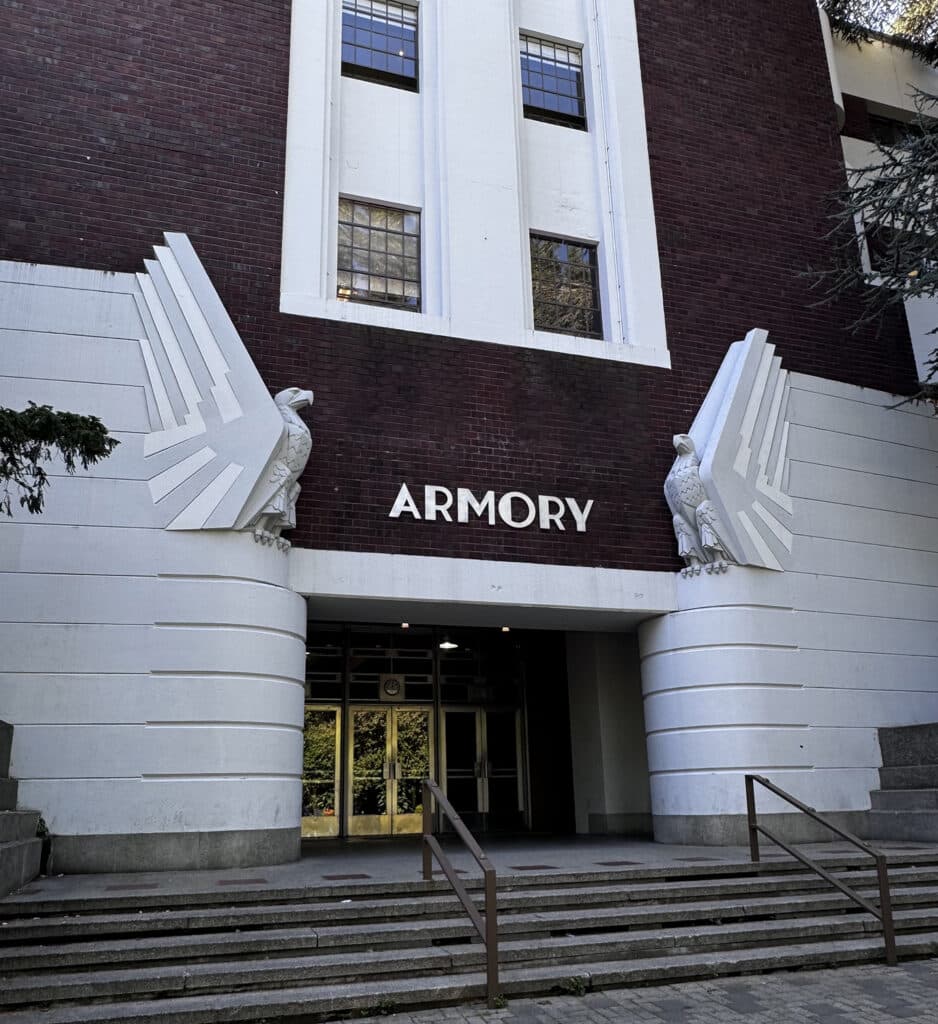
The Armory building at the Seattle Center. Photo by Mary Williams
Often referred to as the Center of the Center, the Armory was built in 1939 to house the U.S. Army’s 146th Field Artillery and its equipment. It is a multi-story building with the second floor serving as the original public space and continuing to host a variety of eating establishments and a main stage.
Memorial Stadium, originally known as Civic Field, opened in 1947. In 1951, a memorial wall honoring Seattle high school students killed in WWII was added. The stadium is now undergoing major renovations. The project is designed to create a multi-purpose sports, education, and entertainment facility. Right now, the only way to access the stadium appears to be through the turnstile, which is only open for scheduled events.
The Seattle World’s Fair
In 1954, City Council member Al Rochester proposed that Seattle host a World’s Fair on the 50th anniversary of the Alaska-Yukon-Pacific Exposition. A group originally known as the Century 21 Commission undertook the planning process.
Two years later, the commission voted unanimously to coordinate the World’s Fair with the city’s effort to develop a civic center at and around the Civic Auditorium. Voters agreed and approved a $7.5 million bond for building and land acquisition.
Gov. Al Rosellini and the Legislature also concurred. The fair was set for 1960, and funding was reallocated from the AYP celebration. The federal government was interested in creating a venue where the U.S. could demonstrate its scientific prowess (The Soviets had just pulled off Sputnik) and committed over $9 million, primarily to build what was to become the Pacific Science Center.
The selection of the Civic Auditorium as the site was confirmed. A chronometer was erected at Boeing Field, President Eisenhower flew in to start the countdown clock, and on-site demolition began. The Armory was reconfigured into a vertical shopping mall, The Food Circus, for the World’s Fair.
The next years were very busy. Plans for what would be known as the Century 21 Monorail received mixed reviews. The Civic Auditorium was remodeled, becoming the Opera House. The fair was postponed until the spring of 1962 to attract more exhibitors. Construction work began on the U.S. Science Pavilion, now the Pacific Science Center.
The World’s Fair Commission decided that a 550-foot observation tower should be constructed. Every once in a while, you hear a story about how some great song was written or a building designed when someone has a bright idea and grabs a scrap of paper to outline a masterpiece. This is one of those times. Commission chair Eddie Carlson drew a quick sketch of a tower on a cocktail napkin, and a plan was hatched to build what is now the Space Needle.
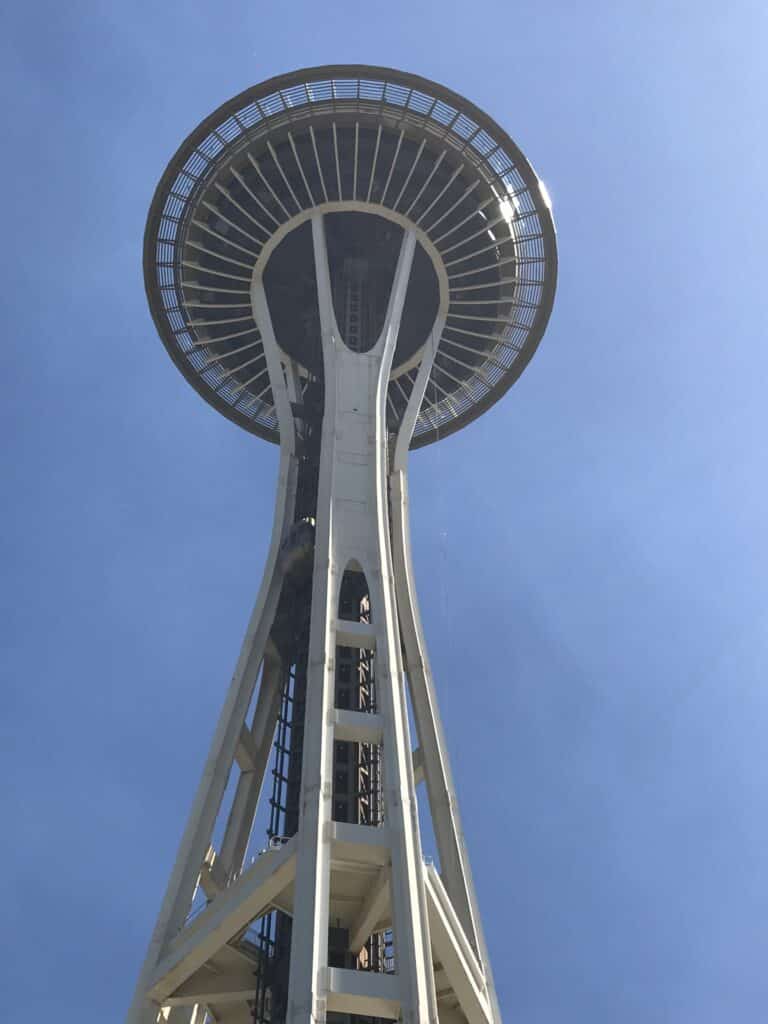
The Space Needle. Photo by Mary Williams
President John F. Kennedy opened the World’s Fair on April 21, 1962. By the time it closed six months later, more than 10 million people had visited the grounds. Twenty-three nations and 35 states participated. Despite a cost of $47 million, the fair recorded a net profit of $100,000.
The Fair closed on October 21, 1962. As the property transitioned to the city in 1963, post-fair life got underway. In November of that year, the Seattle Repertory staged its premier performance at the playhouse, and soon after the Seattle Opera presented its first season.
The next chapter
After the fair closed, many people assumed the area would be deconstructed as quickly as it popped up. Fortunately, wiser heads prevailed, and at least half of the structures were eventually preserved.
The city purchased the Monorail in 1965, and at the same time made the Seattle Center a department of the city.
After nearly 60 years, as you can imagine, much has changed. Some buildings have been renovated, and others added. There is so much to do at the center that I couldn’t possibly cover it all here. I will tell you about six of my family’s favorite things to do.
Once you’ve decided what you’d like to do and made your next journey to the new and improved Seattle Center, you can decide what most appeals to you. Hopefully you’ll visit many more times. And, hopefully, this brief history of how all these venues began gives you a better understanding and appreciation for what it took for this vibrant area to become the cornerstone of the community.
Climate Pledge Arena
Nee Washington State Pavilion, the Seattle Center Coliseum and Key Arena.
The state of Washington paid for construction of the original building, dubbed the Washington State Pavilion and completed just in time for the World’s Fair. After the fair, the city of Seattle bought it for $2.9 million.
The city renovated it to accommodate sports and concerts, then renamed it the Seattle Coliseum. From 1967 to 1978 (and again from ’85 to ’94), it served as the home of the Seattle Supersonics. It also hosted many major events, including two Beatles concerts, an NBA All-Star Game, and two NBA Finals.
The condition of the Coliseum deteriorated to the point that the Sonics played their 1994-95 season at the Tacoma Dome. In 1995, the structure was extensively renovated to add seating and modernize the facility. The unique roof structure was carefully maintained.
Despite the renovations, some around the NBA felt that the facility was too small and didn’t meet the requirements of an NBA facility. The Sonics ownership group lobbied extensively for $220 million in public funding to upgrade the arena but was not successful. In 2008, a couple years after a new ownership group bought the team, they moved it to Oklahoma City.
The settlement agreement reached with the city and the Sonics when that happened included repayment of bonds issued for the building’s 1995 renovation and additional funding to make further improvements to its seating, lounge, and concession spaces. Despite the departure of the Sonics, annual attendance at Key Arena averaged about 550,000.
In 2020 Amazon bought the naming rights to the rebuilt arena and renamed it Climate Pledge Arena.
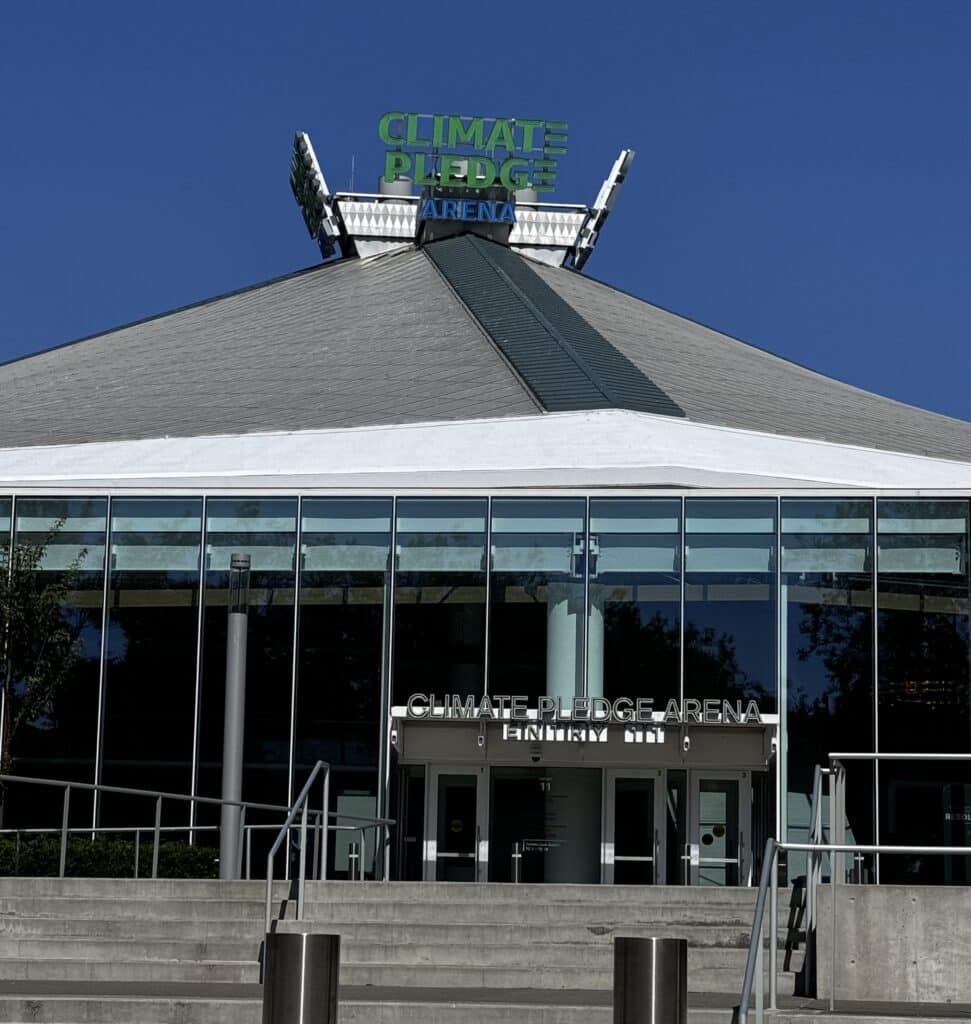
Climate Pledge Arena. Photo by Mary Williams
Climate Pledge Arena was designed to be a regular reminder of the urgent need for climate action. Founded by Amazon and Global Optimism in 2019, the Climate Pledge is a commitment from companies globally to produce net zero carbon by 2040.
Redevelopment of the arena complex was financed and paid for privately by the Oak View Group (OVG) and its partners through a development and lease contract with the city. Included in the construction is a large 15,000-gallon cistern to capture rainwater off the roof to make the ice for NHL’s Seattle Kraken.
The Kraken and the WNBA’s Seattle Storm play at Climate Pledge Arena. Many hope the revived Sonics will join them some day.
Seattle has been home to many sports stars. Figure out how to give a friend directions to the corner of Seattle Storm Way, Lenny Wilkens Way, 2nd Ave N, and Sue Bird Court!
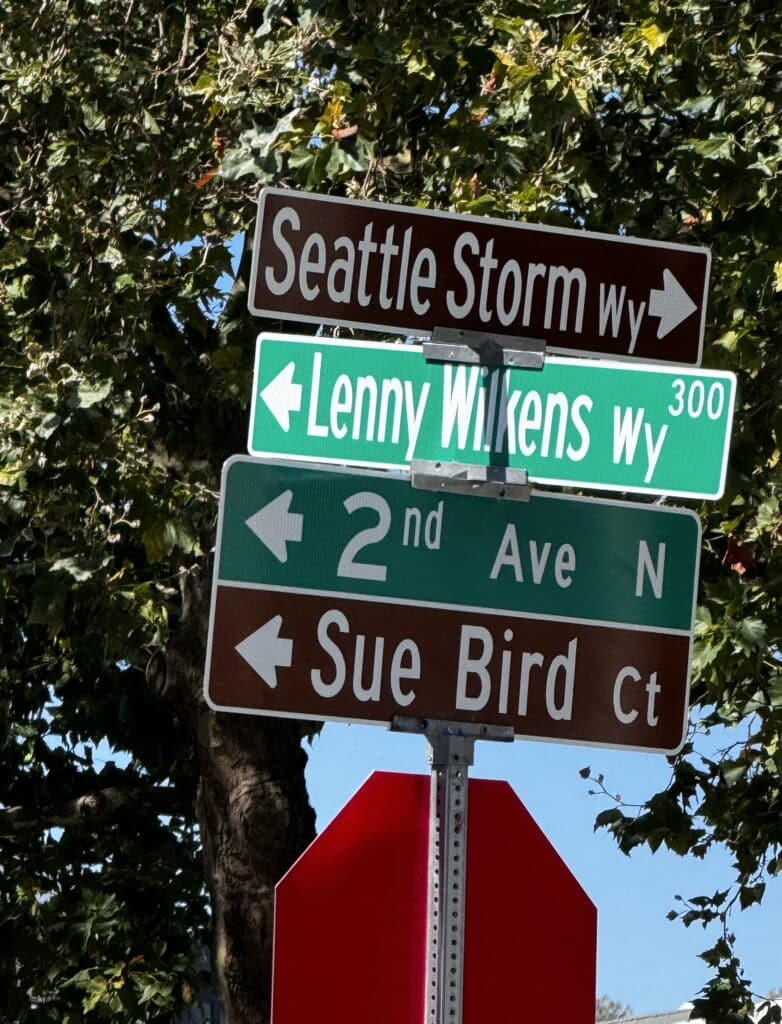
A very Seattle street corner. Photo by Mary Williams
Space Needle
From a quick rendering on a cocktail napkin to an iconic, enduring city logo: That’s the journey of the Space Needle.
The original cost to build it was $4.5 million, and it was completed in 400 days. The Needle was designated an official Seattle landmark in 1999.
The Needle’s foundation includes 5,600 pounds of concrete and it is held together by 74,000 bolts. In case you were thinking you need to get some exercise (and could get permission) there are 848 stairs from the Needle’s basement to the Observation Deck. An elevator ride is much faster — the cars move at 800 feet per minute.
Once you get to the top, a complete revolution of the glass floor takes 45 minutes.
Sixty-nine million people visited the Needle from 1962 to 2024, which is no surprise since it is the No. 1 tourist destination in the Pacific Northwest.
The tower’s 520-foot saucer-shaped top house offers visitors the only 360-degree panoramic view of the Puget Sound. From the observation deck, you can see Mount Rainier, the Puget Sound, and both the Cascade and Olympic mountain ranges.
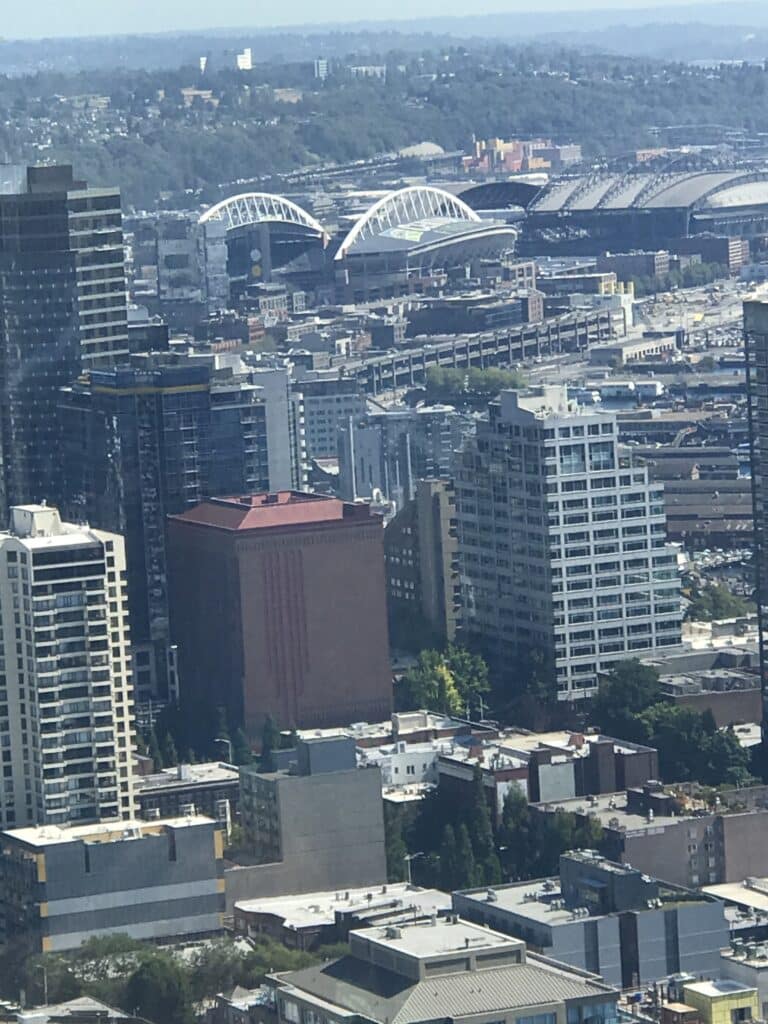
You could theoretically watch both a Seahawks game and a Mariners game from atop the Space Needle. Photo by Mary Williams
If you’ve decided to take advantage of the 9 a.m. parking bargain, don’t worry, you’ll have something to do. The Needle opens at 9 a.m. opens every day. It closes at 9 p.m. Monday, Tuesday and Thursday; 10 p.m. Sunday and Wednesday; and 11 p.m.Friday and Saturday. If you just want to pay for general admission, prices range from $29 to $46.50 for two level access; adding access to the higher levels raises the price to $54.50 to $69.50. There are a whole bunch of other options available. Check out the CityPass or the combined admission to the Needle and the Garden and Glass.
Chihuly Garden and Glass and The Bar at Chihuly
Nee Collections Café.
Collections Café had become a fixture at the Seattle Center. In its location next to Chihuly’s Garden and Glass exhibit, the café had welcomed guests to its unique interior since July 2012. The café closed during the pandemic and reopened in March 2023 as The Bar at Chihuly.
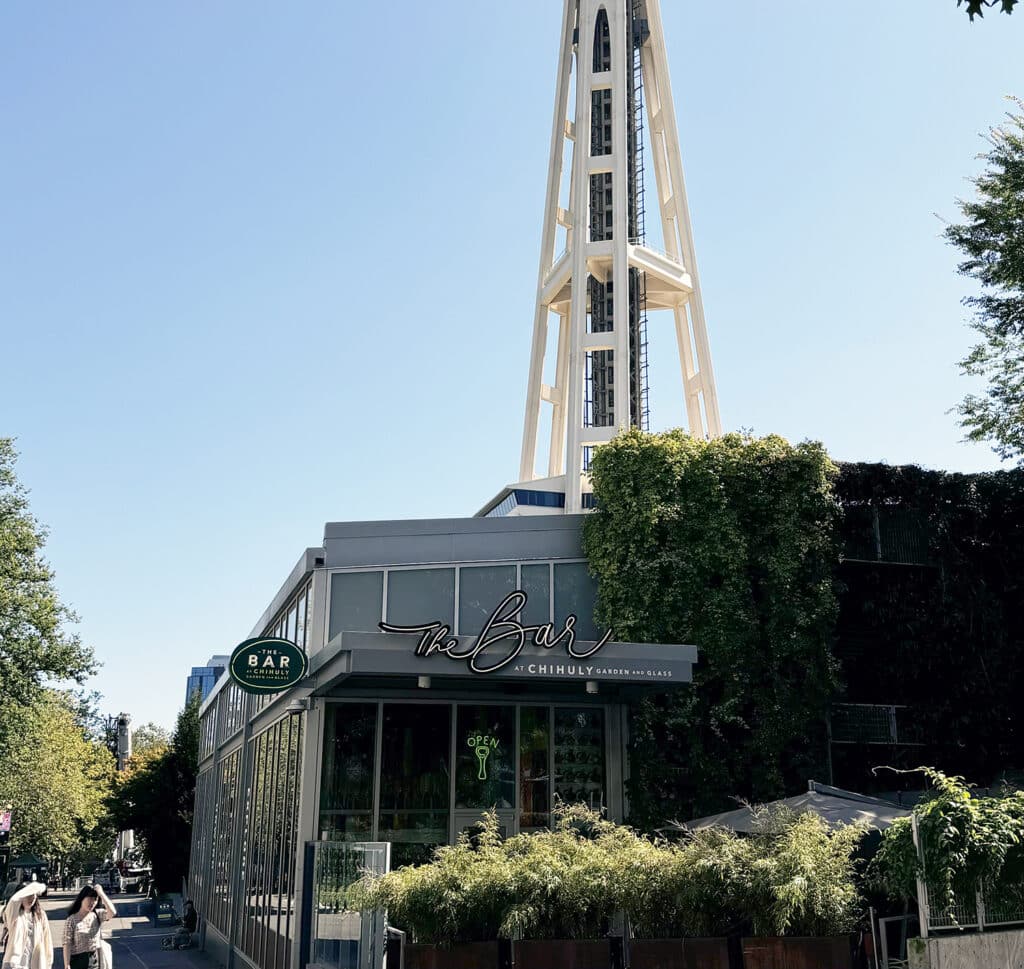
The Bar at Chihuly. Photo by Mary Williams
While it has been extensively renovated, it still includes more than 25 of Chihuly’s personal and eclectic collections. Each table features a different collection. Included are transistor radios, alarm clocks, shaving brushes and fishing lures, among others.
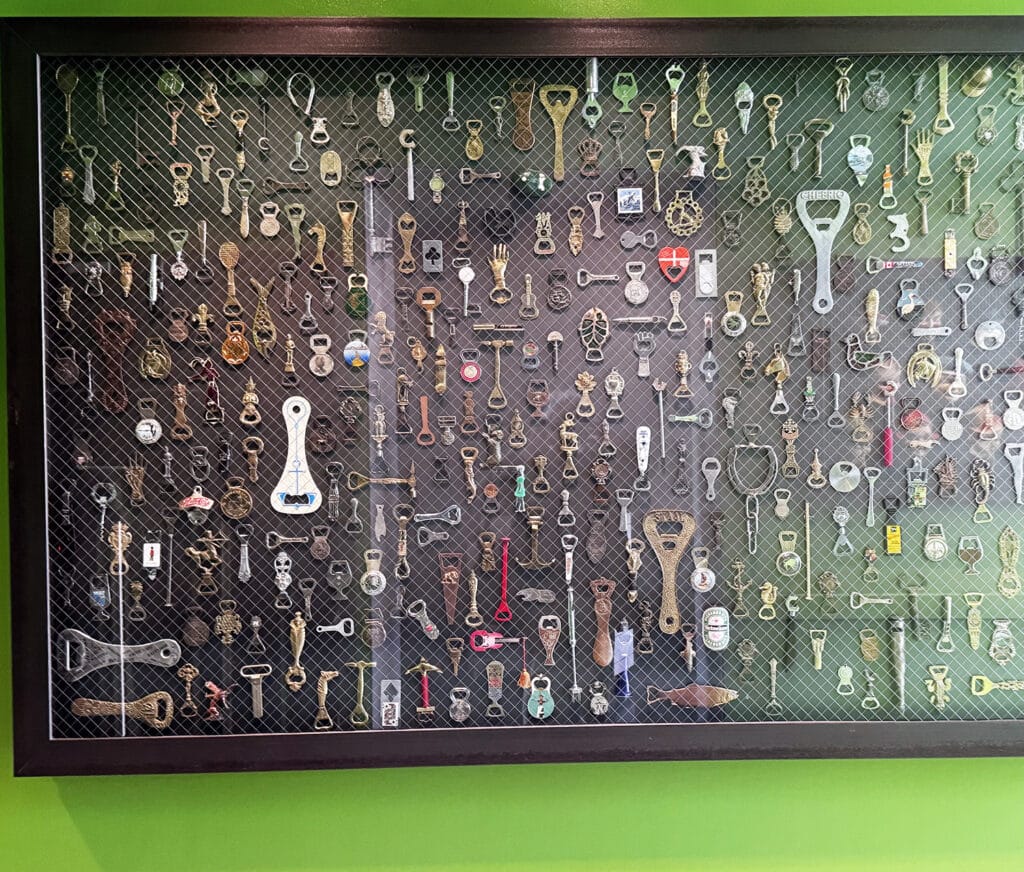
One of the collections at The Bar at Chihuly. Photo by Mary Williams
The ceiling is covered with dozens of accordions that act as both a sound buffer and unique chandeliers. Don’t miss the illuminated installation of 36 of Chihuly’s signature drawings.
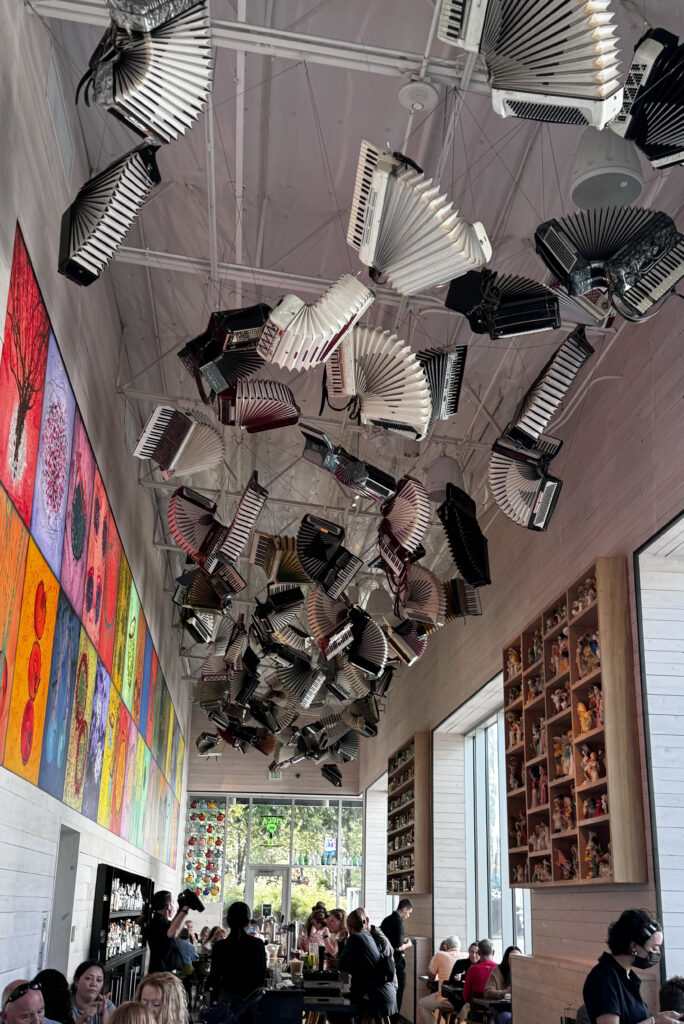
Accordians dangle from the ceiling of The Bar at Chihuly. Photo by Mary Williams
The bar now features an extensive drink menu of unusual drinks, regional beers, and wine. Small bites such as stuffed olives, mussels, and Wagyu sliders are also available.
The Bar and the Garden and Glass area are open seven days a week. The Garden and Glass hours vary. It opens at 9 a.m. weekends and 9:30 a.m. weekdays. It closes at 7 p.m. weekdays, 5:30 on Saturday, and 8 p.m. on Sunday. Check their website as hours may change as we move into fall and winter. The Bar is open from 10:30 a.m. to 8 p.m. daily. The website also includes a convenient map of the center and information about the Monorail and parking.
The Garden and Glass combines elements of each area of Chihuly’s work including drawings, glass creations and architectural installations. The exhibitions include live glass demonstrations, the Glasshouse, and the garden.
The Garden would do Mother Nature proud. There are colorful trees, shimmering plants, and radiant flowers. Learn how Chihuly and his team create the vibrant works of art and project installations by watching a series of short videos in the Theater. Or wander the The Galleries while admiring samples of Chihuly’s more than 40 years of work.
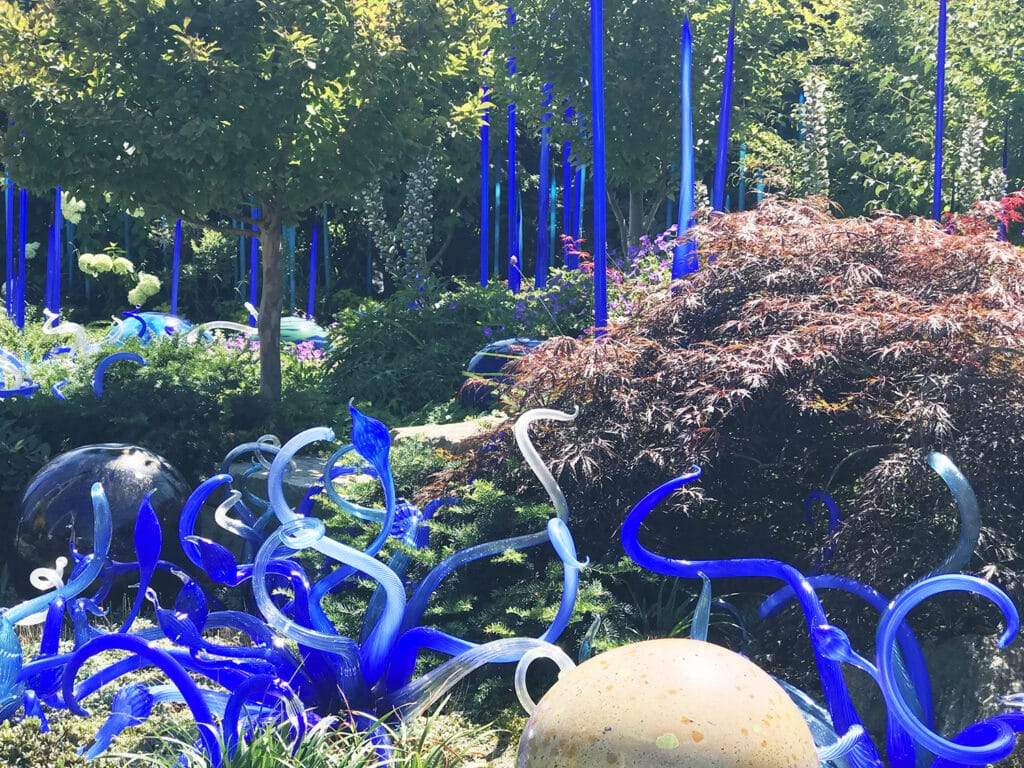
Chihuly’s Garden and Glass. Photo by Mary Williams
Finally, don’t miss the Glasshouse, which features a 100-foot-long sculpture suspended from the ceiling. The displays include both existing work, and new art pieces created just for this exhibition.
MoPop
Nee the Music Experience Project.
The Museum of Pop Culture is dedicated to music, science fiction and pop culture. It includes exhibits focusing on music icons like as Jimi Hendrix and Nirvana. Science fiction exhibits include original props and artifacts from movies like The Matrix and Terminator.
An example the many exhibits at MoPop is a life-size bronze statue of the late Chris Cornell, singer for the Seattle grunge band Soundgarden.
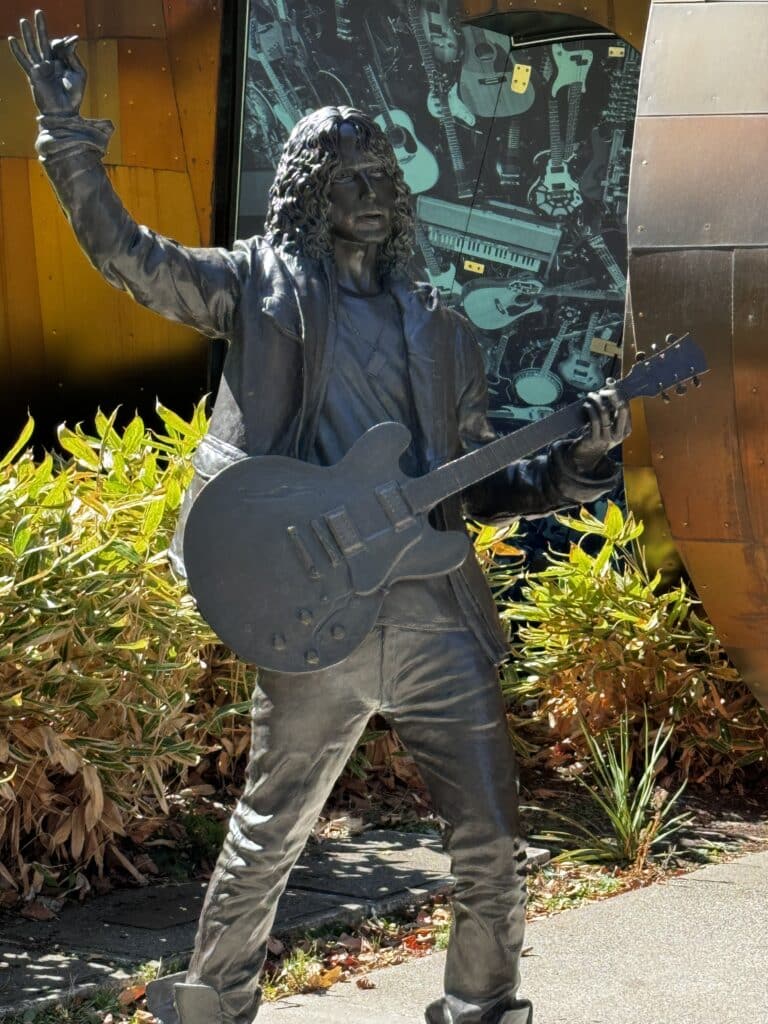
The Chris Cornell statue outside MoPop. Photo by Mary Williams
MoPop maintains an extensive permanent collection and has an online “collections vault” containing over 80,000 pieces. It is available to researchers, scholars, and anyone interested in a more in-depth pop culture-focused research project. The collection is accessible at [email protected].
I’ve visited MoPop several times before my most recent visit to the center. One of my favorite examples of pop culture exhibits was a typewriter eraser sculpture by Claes Oldenburg and Coosje Van Bruggen. That may be because back in the day, when I was a young administrative assistant, a typewriter eraser was essential to my tool kit.
Today, hardly anyone under 35 knows what that thing was for. (Heck, I’m not sure that most people under 30 would recognize a typewriter if they saw one.) The sculpture was part of Paul Allen’s personal collection and was displayed at the Olympic Sculpture Park before moving to MoPOP. Allen’s estate sold much of his collection at auction. For the last years of its time in Seattle, its primary purpose was to be a climbing toy. The sculpture sold for $8.4 million. A very expensive climbing toy.
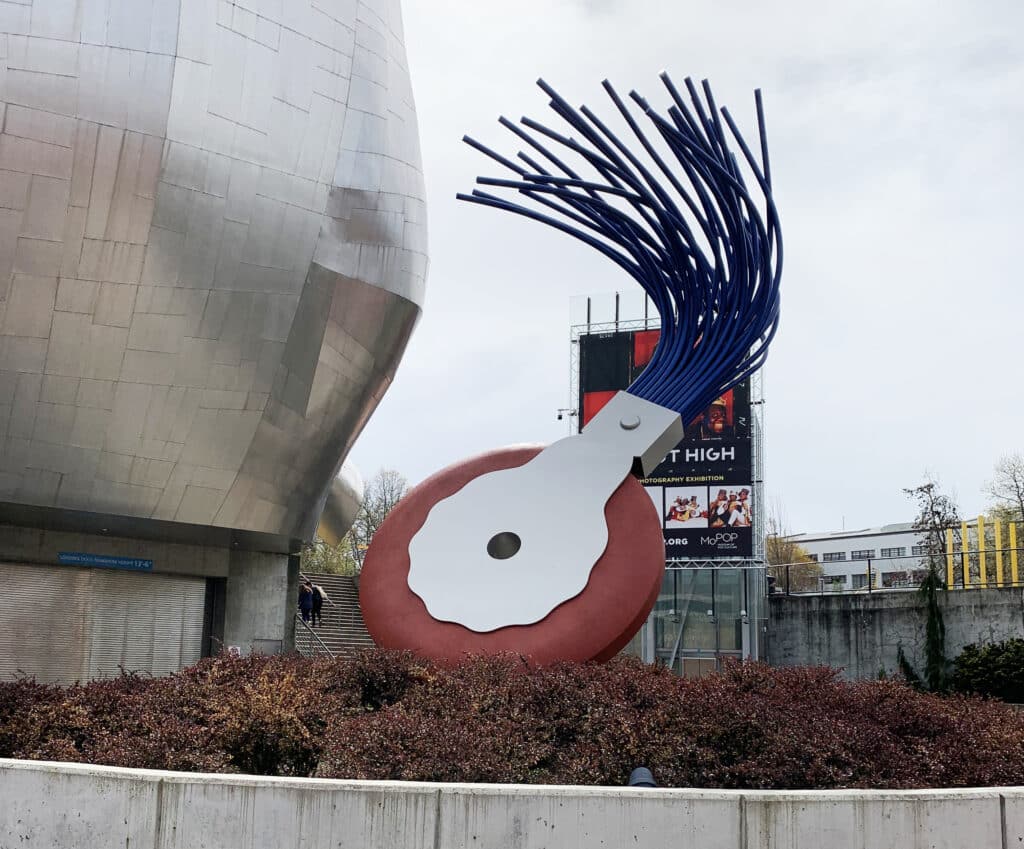
This is what a typewriter eraser looked like. Photo by Mary Williams
I was fortunate enough to see the eraser sculpture when I was at MoPop for the Disney Villains Costume exhibit in 2021. While both have been gone for quite a while, they are representative of the fascinating exhibits they have there. You can check out what’s coming by occasionally visiting the website. You may also want to join their mailing list so that when a new event is scheduled, they let you know about it.
Pacific Science Center
Nee U.S. Science Pavilion.
The law authorizing construction of (and paying for) the Science Center in 1962 required the buildings be used only for governmental purposes. The thought was to use the building as a warehouse and then tear it down.
The original six exhibit buildings were designed as windowless concrete boxes. The 475 wall panels were precast and pre-stressed offsite. The original design called for a single, 110-foot tower, instead of the five iconic arches that were eventually constructed. The architect changed his plans when he learned of Space Needle about to be installed nearby, which he feared would dwarf his design.
The Science Center administration does what it takes to maintain and preserve the buildings. The benches, fountains, and flower bowls are all original pieces installed in 1962. The eight original 500-watt floodlights in each arch and four 400-watt bulbs, have been replaced with LED lights, reducing energy usage by more than 80%. In 2011, the original ponds were refurbished and resealed contributing to a 52% reduction in water use since 2004.
There’s something to do at the Science Center that will entertain every member of the family. The youngest will enjoy an area called Just for Tots. Older kids might be interested in areas with a saltwater tide pool, a dinosaur exhibit or a maker space. Even adults will find areas of interest such as Bodyworks and a butterfly house.
The center includes an IMAX Theater, a Laser Dome, and a Planetarium. If you’re interested in any of these, either plan to arrive early to get your tickets or buy them online before you arrive. Check out the website for more information.
Memorial Stadium
Nee Civic Field.
Memorial Stadium has provided a backdrop for many of the most important events hosted by Seattle Public Schools over the past 80 years. The school district and city began planning a renovation in 2017. The idea is to replace the stadium with a multi-use facility.
SPS retains ownership of the property and priority use for student events. Current plans are for construction to begin in mid-2025 with a projected completion date in late 2026 or 2027.
The project is designed to create a multi-purpose sports, education, and entertainment facility. It will provide an opportunity for workforce development and career and technical education in areas such as cultural, culinary, and the performing arts. Programs in subjects such as sports management, science and journalism are also envisioned.
One of the most significant events to ever take place at the Stadium was the final Seattle concert series of the Grateful Dead in May of 1995. The group’s lead singer Jerry Garcia died the following summer.
Provided I’m still road-tripping three years from now (and I certainly plan to be), we’ll go back and check out the new stadium then.
Monorail
Nee Century 21 Monorail.
Construction on the Monorail began in April 1961, underwritten by Alweg Rapid Transit Systems. It opened in March 1962, just a month before the start of the World’s Fair, and cost $3.5 million to build. During the six months of the fair, it carried more than 8 million passengers. The entire system was eventually sold to the city in 1965 for $600,000.
The two trains run on a guideway that is just under 1 mile long. The north terminus is adjacent to Memorial Stadium and the Armory at the Seattle Center, while the South Station empties at Westlake Center in downtown Seattle.
Kids under 5 ride free. Adult tickets (ages 19-64) are $3.50 for a one-way ride. Youth, seniors over 65, and selected others pay half-price. Orca cards are accepted.
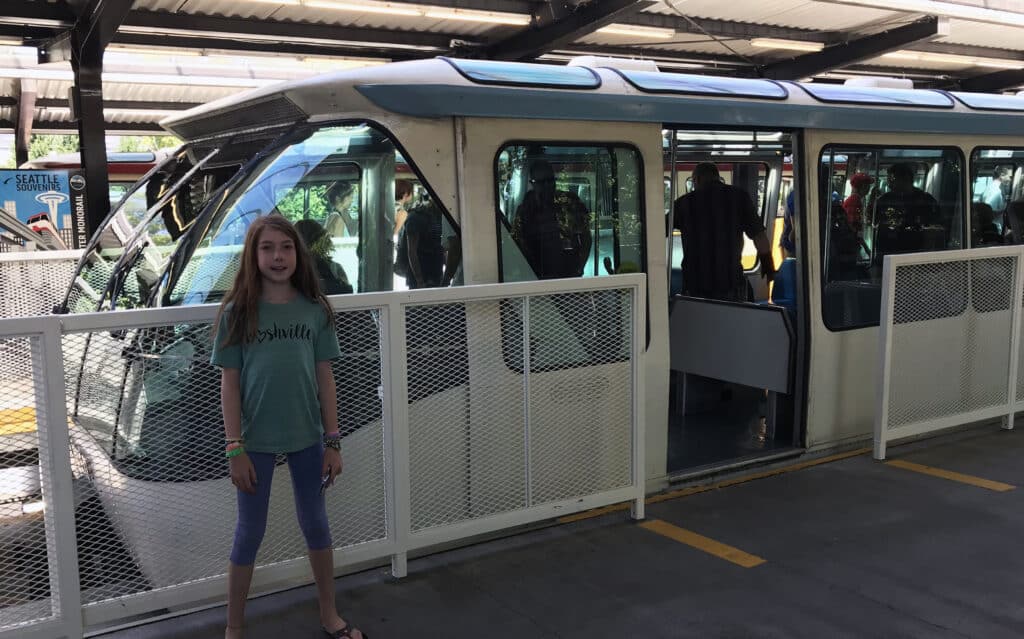
The Seattle Monorail. Photo by Mary Williams
About the Day Tripper column
Gas prices are sky high, and a night in a hotel is approaching astronomically expensive. So, for the foreseeable future, I imagine many of you are going to find yourselves taking day trips rather than the road trip vacations we’ve grown to love.
This beautiful region in which we live is ripe with opportunities to explore new places, see new things, and learn a little something at the same time. I promise to keep the longest journeys to a one-way distance of under 200 miles. Whether you want to make it an overnight trip, a weekend, or just a very long day trip, we should be able to pull it off.
I hope you’ll grant me the honor of your virtual company as we travel these roads together. Happy trails!

